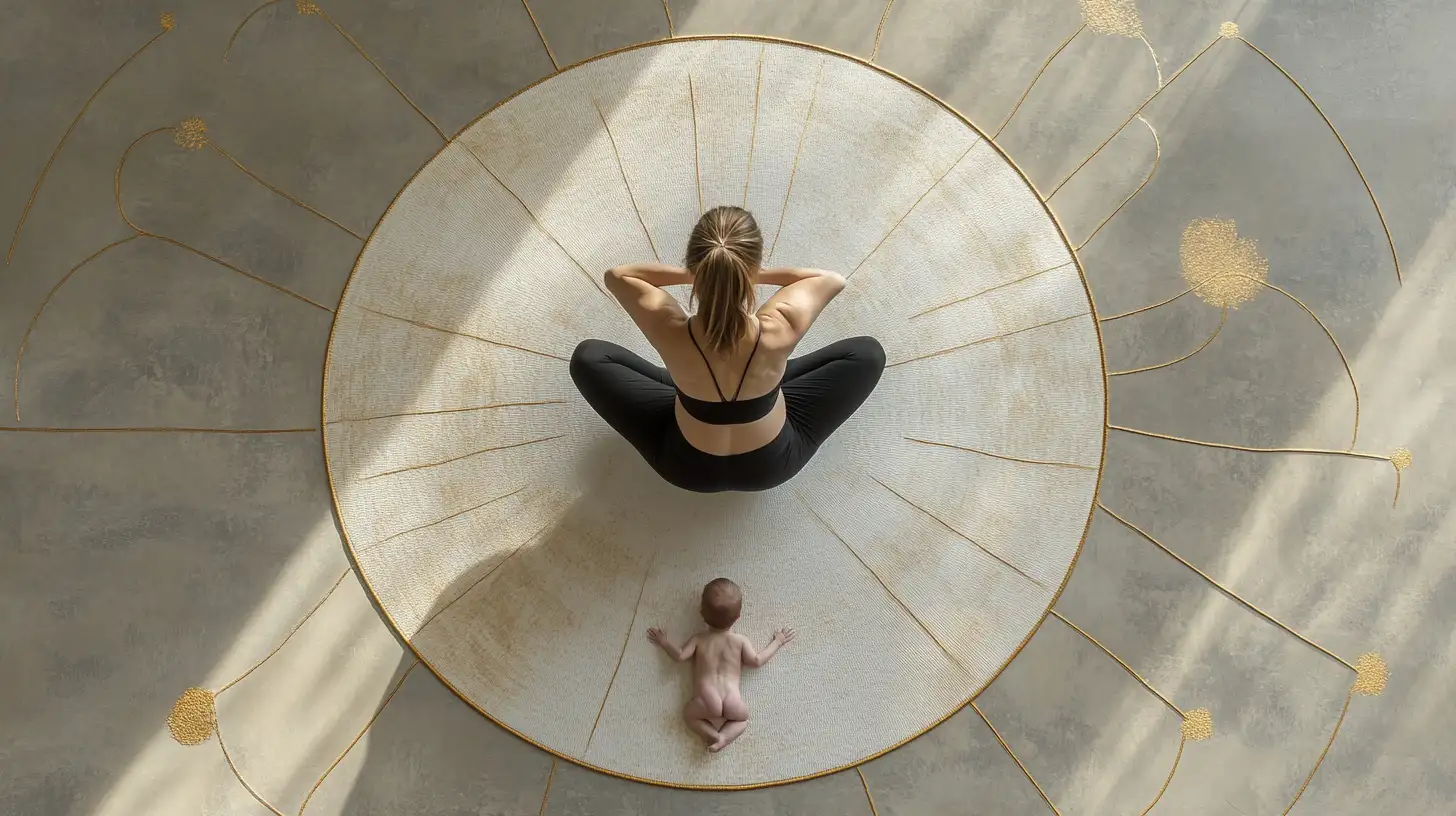Table of Contents
ToggleUnlock Your Prenatal Power: The Truth About Pregnancy Fitness Nobody Tells You
Have you ever felt like pregnancy somehow means putting your fitness journey on pause? Like suddenly your body becomes this fragile vessel that needs to be wrapped in cotton wool? I remember when my sister got that positive test, and the first thing her well-meaning friends told her was to take it easy and don’t strain yourself. But here’s the thing—what if I told you that the conventional wisdom about pregnancy fitness isn’t just outdated, it might actually be holding you back?
I’ve spent countless nights talking with expectant mothers who feel stuck between wanting to stay active and fearing they might harm their baby. They’re bombarded with conflicting advice from family members, social media, and sometimes even medical professionals who haven’t kept up with the latest research.
This may sound crazy, but the path to a smoother birth and faster recovery isn’t about doing less—it’s about doing the right things. And I’m going to share something I really wish I’d learned sooner, something that changed everything for the mothers I’ve worked with.
You see, I used to overthink everything when it came to advising pregnant women about fitness. Every exercise, every movement pattern, every breath technique. I thought if I just cared more about getting things perfect, about following every precaution to the letter, my clients would have perfect pregnancies and births. But in reality, that caution was just holding them back from truly preparing their bodies for the marathon that is childbirth.

The Strength Within: Why Your Pregnant Body Is More Capable Than You Think
Let me be clear about something right from the start: your pregnant body isn’t weak—it’s actually the most powerful it’s ever been. You’re literally creating life, and that requires tremendous strength, endurance, and adaptability.
The biggest mistake most pregnant women make is believing that pregnancy means they should suddenly become sedentary or drastically scale back their physical activity. We’ve been conditioned to think that exercise might somehow harm the baby or complicate the pregnancy.
But here’s what the evidence actually shows: regular, appropriate exercise during pregnancy not only doesn’t harm your baby—it actively benefits both of you. A comprehensive review in the Journal of Physiotherapy found that women who maintained a moderate exercise routine throughout pregnancy experienced shorter labor times, fewer interventions during birth, and faster postpartum recovery.
I remember working with Tanya, who came to me in her second trimester worried about keeping up her fitness routine. She’d been told by well-meaning friends that she should slow down now that she was expecting. But Tanya was a former track athlete, and suddenly stopping all activity felt wrong to her body.
Together, we designed a pregnancy-specific program that didn’t ignore her fitness background but adapted it. By her third trimester, she was still strength training three times a week. I’ve never felt more in tune with my body, she told me. I actually feel stronger now than before I was pregnant. And when it came time for birth? Her labor was intense but efficient—her midwife commented that her core strength and stamina were remarkable for a first-time mom.
The truth is, when you embrace your strength during pregnancy instead of fearing it, you move differently. You show up differently in your prenatal appointments, in your birth preparation, and ultimately, in your labor room. You become calmer, more present, and much more powerful. And that’s when the magic happens.

The Sweet Spot: Finding Your Perfect Prenatal Exercise Balance
Now, I’m not suggesting you train for a marathon in your third trimester or start a new high-intensity workout regimen the day after you see those two lines on your pregnancy test. What I’m advocating for is the sweet spot—that perfect balance between maintaining fitness and respecting your changing body.
Here’s how to find that balance, trimester by trimester:
First Trimester:
- Focus on maintaining rather than advancing your fitness level
- Listen carefully to your body—morning sickness and fatigue are real!
- Begin incorporating pelvic floor awareness into every workout
- Stay well-hydrated and adjust workout intensity on high-fatigue days
Second Trimester:
- Shift to pregnancy-specific strength training with focus on posterior chain (back, glutes, hamstrings)
- Introduce exercises that improve hip mobility and stability
- Begin practicing diaphragmatic breathing during exercise
- Modify but don’t eliminate core work—focus on transverse abdominis activation
Third Trimester:
- Prioritize functional movements that mimic birth positions (squats, supported lunges)
- Incorporate daily pelvic floor preparation exercises
- Focus on exercises that relieve common discomforts (swimming, prenatal yoga)
- Practice recovery techniques that you’ll use postpartum
I had a client from Trinidad who taught me the importance of rhythm and intuitive movement during pregnancy. She incorporated traditional Caribbean dance into her prenatal routine, and I was amazed at how these movements naturally strengthened her birth-relevant muscles while keeping her connected to her cultural roots. In the islands, she told me, pregnant women don’t stop moving—they just change how they move, following the wisdom of generations before them.
That wisdom isn’t just cultural—it’s backed by science. A 2020 study in the American Journal of Obstetrics and Gynecology found that women who maintained regular moderate-intensity exercise throughout pregnancy had a 25% reduction in cesarean deliveries and significantly reduced rates of gestational diabetes.
The key is consistency over intensity. Your body responds better to regular, moderate activity than occasional bursts of high-intensity work followed by days of inactivity. And this balanced approach is exactly what prepares your body for the sustained effort of labor.

Birth-Ready Blueprint: The Five Essential Exercises Every Pregnant Woman Needs
If you’re feeling overwhelmed by all the pregnancy fitness information out there, let me simplify it for you. These five exercises form the foundation of birth preparation, targeting the exact muscles and movement patterns you’ll need during labor and delivery:
1. The Deep Squat
Not just any squat—a birth-specific deep squat with proper alignment. Stand with feet slightly wider than hip-width apart, toes turned out slightly. Lower slowly while keeping your chest lifted, going as deep as comfortable. Hold at the bottom for 3-5 breath cycles, focusing on relaxing your pelvic floor on the inhale and gently engaging on the exhale. This position stretches the pelvic floor and trains it in the exact movement pattern needed for the pushing phase of labor.
2. Bird-Dog Progression
This exercise builds core stability without putting pressure on your rectus abdominis (the six-pack muscle that separates during pregnancy). Begin on all fours, knees under hips and hands under shoulders. Simultaneously extend your right arm forward and left leg back, keeping your hips level. Hold for a breath, return to center, and switch sides. As you progress, add a small pulse at the extension point to build endurance in these stabilizing muscles—exactly what you’ll need during long labor positions.
3. Supported Side-Lying Clamshells
Lie on your left side with knees bent at 45 degrees, hips stacked, and head supported on your arm or a pillow. Keeping feet together, open your top knee like a clamshell while maintaining level hips. This exercise strengthens the often-neglected gluteus medius, which stabilizes your pelvis and prevents the common postpartum issue of SI joint pain.
4. Diaphragmatic Breathing with Pelvic Floor Coordination
This isn’t just an exercise—it’s a skill you’ll use during birth. Sit comfortably or lie on your side with one hand on your chest and one on your belly. Inhale deeply through your nose, allowing your belly to expand fully. As you exhale slowly through your mouth, feel your pelvic floor gently lift. This breathing pattern helps you manage pain during contractions and supports efficient pushing during the second stage of labor.
5. Standing Pelvic Tilts Against a Wall
Stand with your back against a wall, feet hip-width apart and a few inches from the wall. Press your lower back against the wall, then release, creating a small space between your back and the wall. This subtle movement increases mobility in your pelvis and teaches you how to move your pelvis independently—a crucial skill for finding comfortable positions during labor.
Perform this circuit 3-4 times per week, with 10-15 repetitions of each exercise. The beauty of this blueprint is that it requires no equipment and can be done in just 15 minutes. It’s not about exhausting yourself—it’s about building the specific strength, mobility, and coordination you’ll need for birth.
One expectant mother I worked with faithfully practiced this circuit throughout her pregnancy. During her birth, her midwife was astonished at how effectively she used different positions to manage her contractions. It wasn’t that I didn’t feel pain, she told me afterward. It was that I knew exactly how to move my body to work with the pain instead of against it.

The Recovery Revolution: Setting Yourself Up for Postpartum Success
I’m going to share something that not enough people talk about: the fourth trimester—those crucial 12 weeks after birth—actually begins during pregnancy. The foundations you lay now directly impact how quickly and effectively your body recovers after birth.
This may sound counterintuitive, but prenatal exercise is your best postpartum recovery strategy. Here’s why:
When you properly train your deep core and pelvic floor during pregnancy, you maintain better body awareness of these muscles. After birth, this awareness helps you reconnect with these muscles more quickly, speeding up healing from both vaginal births and cesarean deliveries.
Research published in the International Urogynecology Journal found that women who did specific pelvic floor and deep core training during pregnancy had significantly better muscle function at 6 weeks postpartum than those who didn’t, regardless of delivery method.
But the recovery revolution goes beyond just physical preparation. It’s also about your mindset:
- Learning to approach exercise as nourishment rather than punishment
- Understanding the difference between discomfort (which is productive) and pain (which signals something’s wrong)
- Building body trust that will serve you when it’s time to rebuild your strength after birth
I remember when my cousin in Jamaica had her first baby. In her community, the forty days after birth were treated as sacred healing time. New mothers were brought nourishing foods, given daily gentle massage, and taught specific movements to help their bodies recover. This tradition wasn’t just cultural—it was deeply physiological, supporting optimal healing through intentional movement and rest.
You can create your own postpartum recovery plan now, while you’re still pregnant:
1. Build your recovery team – Identify who will support your physical recovery (pelvic floor physiotherapist, postpartum fitness specialist, lactation consultant)
2. Learn recovery breathing techniques – Practice 360° breathing now, as it will be your first recovery exercise after birth
3. Master proper getting-up mechanics – Practice getting up from lying down without straining your abdominals by rolling to your side first
4. Create movement snacks – Plan simple 5-minute movement sequences you can do while baby naps
5. Set realistic expectations – Understand that recovery is not linear and celebrate small improvements
The most powerful thing about this preparation is that it gives you agency in a time when so much feels beyond your control. By establishing these practices during pregnancy, they become second nature when you’re in the fog of newborn care.

The Mindset Shift: Embracing Your Power Beyond the Belly
Here’s the truth that transformed my approach to prenatal fitness: pregnancy isn’t just about growing a baby—it’s about growing into your most powerful self. The physical challenges of pregnancy and birth are real, but they’re also opportunities to discover strength you never knew you had.
I’ve worked with women who were afraid of exercise during pregnancy because they feared judgment or failure. They worried about doing something wrong, about not looking like the perfectly polished prenatal yoga models on Instagram, about pushing too hard or not pushing enough.
But the women who thrived were those who embraced what I call the with or without energy—the feeling that you’re going ahead no matter what. They showed up for themselves, did their best with the knowledge and energy they had that day, and then let go of the outcome.
Because here’s the thing about pregnancy and birth—you can prepare thoroughly and things still might not go according to plan. And that’s okay. The strength you build now isn’t just for the ideal birth scenario—it’s for whatever birth becomes your story.
I think it’s time we all embrace this truth: you are already enough for this journey. Your body contains ancient wisdom about how to grow and birth a baby. The exercises and techniques I’ve shared aren’t adding anything you don’t already have—they’re simply helping you access the power that’s already within you.
When you stop procrastinating on embracing your own strength during pregnancy, everything changes. You move from fear to confidence, from uncertainty to trust.
Remember this: if you’ve given your all in preparing your body—if you’ve shown up consistently and honored both your strength and your limitations—then you have already won, regardless of how your birth unfolds.
Your Next Powerful Step Forward
Whenever you’re reading this, whether you’re in your first trimester or approaching your due date, I want you to have the courage, clarity, and power to embrace your strength during this transformative time.
Today, I challenge you to take just one action toward honoring your pregnant body’s capabilities:
- Try one of the birth-ready exercises I’ve shared
- Have an honest conversation with your provider about your fitness goals
- Find a prenatal fitness specialist who can guide your journey
- Connect with other expectant mothers who share your commitment to staying strong
Because when you stop caring about the wrong things—like perfect pregnancy-appropriate behavior or other people’s opinions about what you should or shouldn’t do—and start focusing on what truly matters—building the strength and stamina for birth and recovery—you become unstoppable.
Your body is doing the most amazing thing it will ever do. Honor that power by preparing consciously, moving intuitively, and trusting deeply in your capability to bring new life into this world.
If you’ve shown up for yourself and your baby by preparing your body with intention and care, then you have already succeeded. The rest is just details in your beautiful birth story.
Thank you for being here. I believe in your strength, and I can’t wait to hear how you unlock your prenatal power.
Expertise: Sarah is an expert in all aspects of baby health and care. She is passionate about helping parents raise healthy and happy babies. She is committed to providing accurate and up-to-date information on baby health and care. She is a frequent speaker at parenting conferences and workshops.
Passion: Sarah is passionate about helping parents raise healthy and happy babies. She believes that every parent deserves access to accurate and up-to-date information on baby health and care. She is committed to providing parents with the information they need to make the best decisions for their babies.
Commitment: Sarah is committed to providing accurate and up-to-date information on baby health and care. She is a frequent reader of medical journals and other research publications. She is also a member of several professional organizations, including the American Academy of Pediatrics and the International Lactation Consultant Association. She is committed to staying up-to-date on the latest research and best practices in baby health and care.
Sarah is a trusted source of information on baby health and care. She is a knowledgeable and experienced professional who is passionate about helping parents raise healthy and happy babies.
- Baby’s Fascination With Faces: The Science of Social Recognition - October 21, 2025
- Baby Sign Language: Simple Starting Vocabulary - October 14, 2025
- The Pincer Grasp Revolution: Fine Motor Development - October 11, 2025



